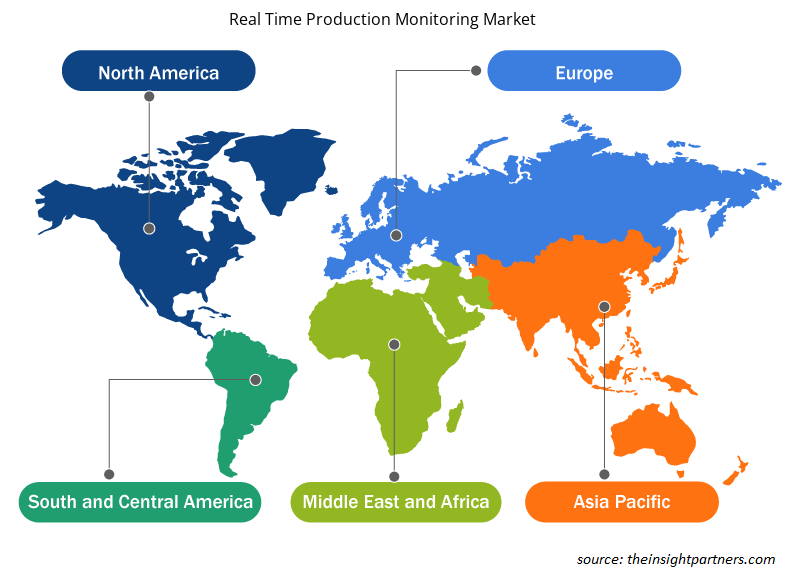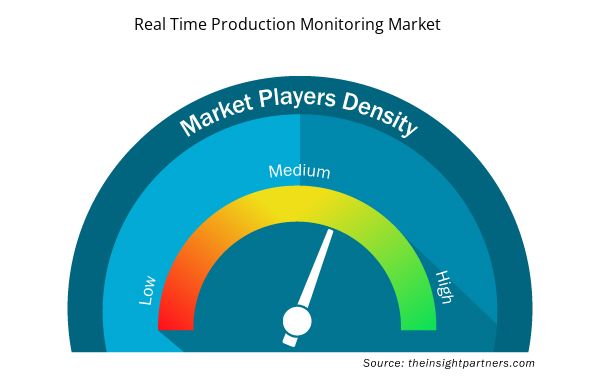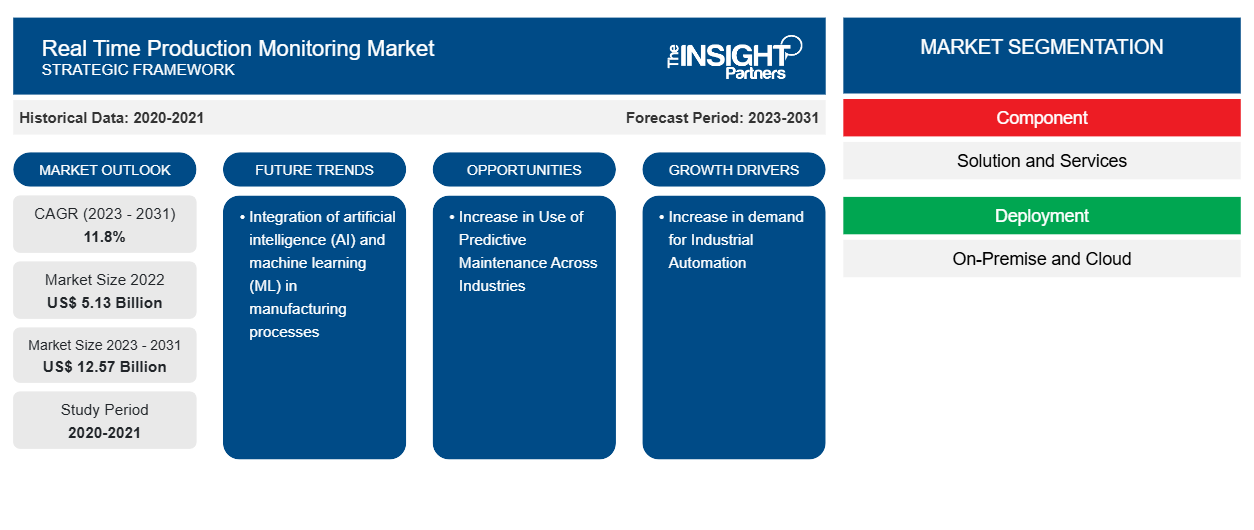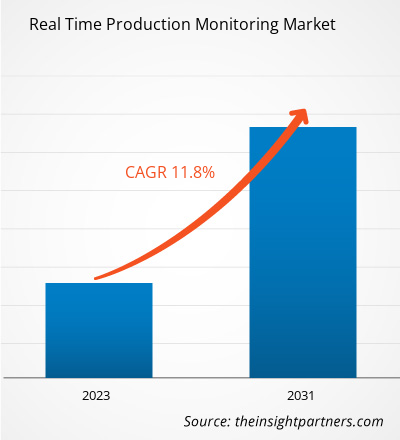من المتوقع أن يصل حجم سوق مراقبة الإنتاج في الوقت الفعلي إلى 12.57 مليار دولار أمريكي بحلول عام 2030 من 5.13 مليار دولار أمريكي في عام 2022. ومن المتوقع أن يسجل السوق معدل نمو سنوي مركب بنسبة 11.8٪ خلال الفترة 2022-2030. ومن المرجح أن يظل دمج الذكاء الاصطناعي (AI) والتعلم الآلي (ML) في عمليات التصنيع اتجاهًا رئيسيًا في السوق.
تحليل سوق مراقبة الإنتاج في الوقت الفعلي
لقد شهد السوق نموًا مطردًا بسبب الطلب المتزايد على التصنيع الرقمي . يؤدي التحول الرقمي في قطاع التصنيع إلى اعتماد العديد من التقنيات من قبل الشركات المصنعة لأنها تساعد في إدارة عملية الإنتاج بكفاءة.
نظرة عامة على سوق مراقبة الإنتاج في الوقت الفعلي
مراقبة الإنتاج في الوقت الفعلي هي حل يساعد في مراقبة عملية الإنتاج. فهو يسجل جميع المعلومات المتعلقة بأداء الإنتاج في الوقت الفعلي. تجمع أنظمة المراقبة بيانات الإنتاج من عدة مصادر لخطوط الإنتاج لصالح الشركة المصنعة أو المشغلين على خط الإنتاج. ثم يتم استخدام البيانات المجمعة لتحسين كفاءة خط الإنتاج من خلال اكتساب رؤى بشأن الخطوات المطلوبة لسير عمل الإنتاج الفعال. تتبنى العديد من شركات التصنيع هذه الحلول لسوق مراقبة الإنتاج في الوقت الفعلي في القطاعات الصناعية، مثل السيارات والمواد الكيميائية والنفط والغاز والآلات والأغذية والمشروبات.
قم بتخصيص هذا التقرير ليناسب متطلباتك
ستحصل على تخصيص لأي تقرير - مجانًا - بما في ذلك أجزاء من هذا التقرير، أو تحليل على مستوى الدولة، وحزمة بيانات Excel، بالإضافة إلى الاستفادة من العروض والخصومات الرائعة للشركات الناشئة والجامعات
- احصل على أهم اتجاهات السوق الرئيسية لهذا التقرير.ستتضمن هذه العينة المجانية تحليلاً للبيانات، بدءًا من اتجاهات السوق وحتى التقديرات والتوقعات.
مراقبة الإنتاج في الوقت الفعلي - محركات السوق والفرص
زيادة الطلب على الأتمتة الصناعية لصالح السوق
تستخدم الأتمتة الصناعية أنظمة التحكم، مثل الروبوتات وأجهزة الكمبيوتر وتكنولوجيا المعلومات، للتعامل مع الآلات المختلفة في الصناعة لتحل محل التدخل البشري. اعتمادًا على العمليات المعنية، يتم تصنيف أنظمة التحكم في الأتمتة الصناعية بشكل أساسي إلى نوعين، وهما أتمتة مصنع العمليات وأتمتة التصنيع. توفر الأتمتة الصناعية جودة عالية للمنتج وموثوقية ومعدل إنتاج مع تقليل تكاليف الإنتاج والتصميم من خلال نشر تقنيات وخدمات جديدة ومبتكرة ومتكاملة. تمتلك ميزات مختلفة، مثل الإنتاجية العالية والجودة والمرونة ودقة المعلومات، والتي من المرجح أن تزيد من استخدام الأتمتة في القطاع الصناعي خلال فترة التنبؤ. كما أن الزيادة في استخدام حلول الأتمتة في صناعات النفط والغاز والتصنيع والمواد الكيميائية والمواد والأدوية وغيرها من الصناعات تدفع نمو سوق مراقبة الإنتاج في الوقت الفعلي.
زيادة استخدام الصيانة التنبؤية عبر الصناعات
مع زيادة التقنيات الرقمية، تستفيد العديد من الصناعات التحويلية من الصيانة التنبؤية. تستخدم هذه الصناعات الذكية بيانات في الوقت الفعلي لأصول التصنيع وتحلل كميات هائلة من البيانات الضخمة التي تكتسبها أجهزة الاستشعار على أرضية المصنع. يتطلب هذا التحليل الصيانة التنبؤية للحد من وقت تعطل المعدات. يمكن لنظام مراقبة الإنتاج في الوقت الفعلي تتبع المعدات وإرسال التنبيهات بحيث يتم تنفيذ العمل فقط عندما يكون ضروريًا بالفعل. أيضًا، يتم توفير هذه الأنظمة غالبًا كوحدات لتكملة أنظمة تخطيط موارد المؤسسة (ERP) بقدرات الصيانة الوقائية المماثلة لتلك الموجودة في نظام إدارة الصيانة المحوسبة القياسي (CMMS).
تقرير تحليل تجزئة سوق مراقبة الإنتاج في الوقت الفعلي
إن القطاعات الرئيسية التي ساهمت في استنباط تحليل سوق مراقبة الإنتاج في الوقت الفعلي هي المكون والنشر وحجم المؤسسة والصناعة.
- بناءً على المكون، يتم تقسيم السوق حسب الحلول والخدمات. احتل قطاع الحلول حصة سوقية كبيرة في عام 2022.
- بناءً على النشر، يتم تقسيم السوق إلى محلي وسحابي. احتل قطاع السحابة حصة سوقية أكبر في عام 2022.
- بناءً على حجم المؤسسة، يتم تقسيم السوق إلى مؤسسات كبيرة وصغيرة الحجم. احتلت شريحة المؤسسات الكبيرة حصة سوقية أكبر في عام 2022.
- بناءً على الصناعة، يتم تقسيم السوق إلى تصنيع العمليات والتصنيع المنفصل. احتل قطاع التصنيع العملياتي الحصة الأكبر من السوق في عام 2022.
تحليل حصة سوق مراقبة الإنتاج في الوقت الفعلي حسب المنطقة الجغرافية
يتم تقسيم النطاق الجغرافي لتقرير سوق مراقبة الإنتاج في الوقت الفعلي بشكل أساسي إلى خمس مناطق: أمريكا الشمالية، ومنطقة آسيا والمحيط الهادئ، وأوروبا، والشرق الأوسط وأفريقيا، وأمريكا الجنوبية والوسطى.
من المتوقع أن تهيمن منطقة آسيا والمحيط الهادئ على السوق في عام 2022. لطالما كانت منطقة آسيا والمحيط الهادئ قاعدة تصنيع قوية، ويستمر القطاع في تبني إنترنت الأشياء بقوة. يتم اعتماد إنترنت الأشياء على نطاق واسع عبر القطاعات الرأسية في جميع أنحاء المنطقة، مما يؤدي إلى اعتماد الحلول الرقمية. تتمتع المنطقة بإمكانات قوية لقوة قطاع التصنيع الخاص بها. في مارس 2023، أعلنت شركة Rockwell Automation Inc. عن نتيجة "تقرير حالة التصنيع الذكي" السنوي الثامن. وفقًا لمسح شمل 1350 شركة تصنيع في دول مثل أستراليا والهند والصين وجمهورية كوريا واليابان، يخطط حوالي 44٪ من الشركات المصنعة في منطقة آسيا والمحيط الهادئ لتبني التصنيع الذكي في غضون العام المقبل، بينما يستخدم حوالي 80٪ من الشركات المصنعة في الصين و60٪ في أستراليا و59٪ في الهند بالفعل بعض مكونات التصنيع الذكي. وبالتالي، فإن التبني المتزايد للتصنيع الذكي ومرافق التصنيع الذكية الحالية يمثل حصة سوقية قوية لمراقبة الإنتاج في الوقت الفعلي في منطقة آسيا والمحيط الهادئ حيث يساعد هذا الحل المرافق الذكية على إدارة سير عمل الإنتاج بكفاءة في الوقت الفعلي.
رؤى إقليمية حول سوق مراقبة الإنتاج في الوقت الفعلي
لقد قام المحللون في Insight Partners بشرح الاتجاهات والعوامل الإقليمية المؤثرة على سوق مراقبة الإنتاج في الوقت الفعلي طوال فترة التنبؤ بشكل شامل. يناقش هذا القسم أيضًا قطاعات سوق مراقبة الإنتاج في الوقت الفعلي والجغرافيا في جميع أنحاء أمريكا الشمالية وأوروبا ومنطقة آسيا والمحيط الهادئ والشرق الأوسط وأفريقيا وأمريكا الجنوبية والوسطى.

- احصل على بيانات إقليمية محددة لسوق مراقبة الإنتاج في الوقت الفعلي
نطاق تقرير سوق مراقبة الإنتاج في الوقت الفعلي
| سمة التقرير | تفاصيل |
|---|---|
| حجم السوق في عام 2022 | 5.13 مليار دولار أمريكي |
| حجم السوق بحلول عام 2030 | 12.57 مليار دولار أمريكي |
| معدل النمو السنوي المركب العالمي (2023 - 2031) | 11.8% |
| البيانات التاريخية | 2020-2021 |
| فترة التنبؤ | 2023-2031 |
| القطاعات المغطاة | حسب المكون
|
| المناطق والدول المغطاة | أمريكا الشمالية
|
| قادة السوق وملفات تعريف الشركات الرئيسية |
|
مراقبة كثافة اللاعبين في السوق في الوقت الفعلي: فهم تأثيرها على ديناميكيات الأعمال
يشهد سوق مراقبة الإنتاج في الوقت الفعلي نموًا سريعًا، مدفوعًا بالطلب المتزايد من المستخدم النهائي بسبب عوامل مثل تفضيلات المستهلك المتطورة والتقدم التكنولوجي والوعي الأكبر بفوائد المنتج. ومع ارتفاع الطلب، تعمل الشركات على توسيع عروضها والابتكار لتلبية احتياجات المستهلكين والاستفادة من الاتجاهات الناشئة، مما يؤدي إلى زيادة نمو السوق.
تشير كثافة اللاعبين في السوق إلى توزيع الشركات أو المؤسسات العاملة في سوق أو صناعة معينة. وهي تشير إلى عدد المنافسين (اللاعبين في السوق) الموجودين في مساحة سوق معينة نسبة إلى حجمها أو قيمتها السوقية الإجمالية.
الشركات الرئيسية العاملة في سوق مراقبة الإنتاج في الوقت الفعلي هي:
- أوراكل
- شركة هيتاشي المحدودة
- روكويل أوتوميشن
- أنظمة داسو
- شركة أسبن للتكنولوجيا
- سيدابت
إخلاء المسؤولية : الشركات المذكورة أعلاه ليست مرتبة بأي ترتيب معين.

- احصل على نظرة عامة على أهم اللاعبين الرئيسيين في سوق مراقبة الإنتاج في الوقت الفعلي
مراقبة الإنتاج في الوقت الفعلي وأخبار السوق والتطورات الأخيرة
يتم تقييم سوق مراقبة الإنتاج في الوقت الفعلي من خلال جمع البيانات النوعية والكمية بعد البحث الأولي والثانوي، والتي تتضمن منشورات الشركات المهمة وبيانات الجمعيات وقواعد البيانات. فيما يلي بعض التطورات في سوق مراقبة الإنتاج في الوقت الفعلي:
- أعلنت شركة كابجيميني، الشركة العالمية الرائدة في خدمات التحول التجاري والتكنولوجي، وشركة شنايدر إلكتريك، الشركة الرائدة في التحول الرقمي لإدارة الطاقة والأتمتة، عن تعاون جديد في مجال تحسين الطاقة. صُمم مركز قيادة الطاقة لمساعدة المؤسسات على تسريع رحلتها نحو إدارة مرافق أكثر ذكاءً وخضرة وكفاءة في استخدام الطاقة، ويستفيد من مزيج فريد من الحلول الرقمية والتقنيات المتطورة لتبسيط إدارة الطاقة وتحسين استهلاكها. (المصدر: كابجيميني، بيان صحفي، مايو 2024)
- أعلنت شركة أوراكل عن قدرات الذكاء الاصطناعي التوليدية الجديدة ضمن مجموعة تطبيقات Oracle Fusion Cloud والتي ستساعد العملاء على تحسين عملية اتخاذ القرار وتعزيز تجربة الموظفين والعملاء. تتضمن أحدث إضافات الذكاء الاصطناعي قدرات الذكاء الاصطناعي التوليدية الجديدة المضمنة في سير عمل الأعمال الحالية عبر التمويل وسلسلة التوريد والموارد البشرية والمبيعات والتسويق والخدمة، بالإضافة إلى توسيع إطار عمل Oracle Guided Journeys لتمكين العملاء والشركاء من دمج المزيد من قدرات الذكاء الاصطناعي التوليدية لدعم احتياجاتهم الفريدة في الصناعة والتنافسية. (المصدر: أوراكل، بيان صحفي، مارس 2022)
تقرير تغطية سوق مراقبة الإنتاج في الوقت الفعلي والمنتجات النهائية
يوفر تقرير "حجم سوق مراقبة الإنتاج في الوقت الفعلي والتوقعات (2020-2030)" تحليلاً مفصلاً للسوق يغطي المجالات التالية:
- حجم سوق مراقبة الإنتاج في الوقت الفعلي وتوقعاته على المستويات العالمية والإقليمية والوطنية لجميع قطاعات السوق الرئيسية التي يغطيها النطاق
- مراقبة الإنتاج في الوقت الفعلي ورصد اتجاهات السوق بالإضافة إلى ديناميكيات السوق مثل المحركات والقيود والفرص الرئيسية
- تحليل مفصل لقوى PEST/Porter الخمس وSWOT
- تحليل سوق مراقبة الإنتاج في الوقت الفعلي يغطي اتجاهات السوق الرئيسية والإطار العالمي والإقليمي واللاعبين الرئيسيين واللوائح والتطورات الأخيرة في السوق
- تحليل المشهد الصناعي والمنافسة الذي يغطي تركيز السوق، وتحليل خريطة الحرارة، واللاعبين البارزين، والتطورات الأخيرة لسوق مراقبة الإنتاج في الوقت الفعلي
- ملفات تعريف الشركة التفصيلية
- التحليل التاريخي (سنتان)، السنة الأساسية، التوقعات (7 سنوات) مع معدل النمو السنوي المركب
- تحليل PEST و SWOT
- حجم السوق والقيمة / الحجم - عالميًا وإقليميًا وقطريًا
- الصناعة والمنافسة
- مجموعة بيانات Excel


- Non-Emergency Medical Transportation Market
- Micro-Surgical Robot Market
- Unit Heater Market
- Clear Aligners Market
- Nuclear Waste Management System Market
- Bathroom Vanities Market
- Hydrocephalus Shunts Market
- Emergency Department Information System (EDIS) Market
- Ceramic Injection Molding Market
- Cling Films Market

Report Coverage
Revenue forecast, Company Analysis, Industry landscape, Growth factors, and Trends

Segment Covered
This text is related
to segments covered.

Regional Scope
North America, Europe, Asia Pacific, Middle East & Africa, South & Central America

Country Scope
This text is related
to country scope.
الأسئلة الشائعة
Capgemini SE, Oracle Corp, Hitachi Ltd, Rockwell Automation Inc, and Siemens AG are among the leading real time production monitoring market.
The estimated value of the real time production monitoring market is expected to reach US$ 12.57 billion by 2030.
The market is expected to grow at a CAGR of 11.8% over the forecast period.
The integration of artificial intelligence (AI) and machine learning (ML) in manufacturing processes is likely to remain a key trend in the market.
Asia Pacific dominated the real time production monitoring market in 2022.
The market has grown steadily due to increasing demand for digital manufacturing. Digitalization in the manufacturing sector leads to the adoption of several technologies by the manufacturers as it helps manage the production process efficiently.
The List of Companies - Real Time Production Monitoring Market
- Oracle
- Hitachi, Ltd.
- Rockwell Automation
- Dassault Systèmes
- Aspen Technology, Inc.
- sedApta
- Siemens
- Capgemini
- Infosys Limited
- GE DIGITAL
The Insight Partners performs research in 4 major stages: Data Collection & Secondary Research, Primary Research, Data Analysis and Data Triangulation & Final Review.
- Data Collection and Secondary Research:
As a market research and consulting firm operating from a decade, we have published and advised several client across the globe. First step for any study will start with an assessment of currently available data and insights from existing reports. Further, historical and current market information is collected from Investor Presentations, Annual Reports, SEC Filings, etc., and other information related to company’s performance and market positioning are gathered from Paid Databases (Factiva, Hoovers, and Reuters) and various other publications available in public domain.
Several associations trade associates, technical forums, institutes, societies and organization are accessed to gain technical as well as market related insights through their publications such as research papers, blogs and press releases related to the studies are referred to get cues about the market. Further, white papers, journals, magazines, and other news articles published in last 3 years are scrutinized and analyzed to understand the current market trends.
- Primary Research:
The primarily interview analysis comprise of data obtained from industry participants interview and answers to survey questions gathered by in-house primary team.
For primary research, interviews are conducted with industry experts/CEOs/Marketing Managers/VPs/Subject Matter Experts from both demand and supply side to get a 360-degree view of the market. The primary team conducts several interviews based on the complexity of the markets to understand the various market trends and dynamics which makes research more credible and precise.
A typical research interview fulfils the following functions:
- Provides first-hand information on the market size, market trends, growth trends, competitive landscape, and outlook
- Validates and strengthens in-house secondary research findings
- Develops the analysis team’s expertise and market understanding
Primary research involves email interactions and telephone interviews for each market, category, segment, and sub-segment across geographies. The participants who typically take part in such a process include, but are not limited to:
- Industry participants: VPs, business development managers, market intelligence managers and national sales managers
- Outside experts: Valuation experts, research analysts and key opinion leaders specializing in the electronics and semiconductor industry.
Below is the breakup of our primary respondents by company, designation, and region:

Once we receive the confirmation from primary research sources or primary respondents, we finalize the base year market estimation and forecast the data as per the macroeconomic and microeconomic factors assessed during data collection.
- Data Analysis:
Once data is validated through both secondary as well as primary respondents, we finalize the market estimations by hypothesis formulation and factor analysis at regional and country level.
- Macro-Economic Factor Analysis:
We analyse macroeconomic indicators such the gross domestic product (GDP), increase in the demand for goods and services across industries, technological advancement, regional economic growth, governmental policies, the influence of COVID-19, PEST analysis, and other aspects. This analysis aids in setting benchmarks for various nations/regions and approximating market splits. Additionally, the general trend of the aforementioned components aid in determining the market's development possibilities.
- Country Level Data:
Various factors that are especially aligned to the country are taken into account to determine the market size for a certain area and country, including the presence of vendors, such as headquarters and offices, the country's GDP, demand patterns, and industry growth. To comprehend the market dynamics for the nation, a number of growth variables, inhibitors, application areas, and current market trends are researched. The aforementioned elements aid in determining the country's overall market's growth potential.
- Company Profile:
The “Table of Contents” is formulated by listing and analyzing more than 25 - 30 companies operating in the market ecosystem across geographies. However, we profile only 10 companies as a standard practice in our syndicate reports. These 10 companies comprise leading, emerging, and regional players. Nonetheless, our analysis is not restricted to the 10 listed companies, we also analyze other companies present in the market to develop a holistic view and understand the prevailing trends. The “Company Profiles” section in the report covers key facts, business description, products & services, financial information, SWOT analysis, and key developments. The financial information presented is extracted from the annual reports and official documents of the publicly listed companies. Upon collecting the information for the sections of respective companies, we verify them via various primary sources and then compile the data in respective company profiles. The company level information helps us in deriving the base number as well as in forecasting the market size.
- Developing Base Number:
Aggregation of sales statistics (2020-2022) and macro-economic factor, and other secondary and primary research insights are utilized to arrive at base number and related market shares for 2022. The data gaps are identified in this step and relevant market data is analyzed, collected from paid primary interviews or databases. On finalizing the base year market size, forecasts are developed on the basis of macro-economic, industry and market growth factors and company level analysis.
- Data Triangulation and Final Review:
The market findings and base year market size calculations are validated from supply as well as demand side. Demand side validations are based on macro-economic factor analysis and benchmarks for respective regions and countries. In case of supply side validations, revenues of major companies are estimated (in case not available) based on industry benchmark, approximate number of employees, product portfolio, and primary interviews revenues are gathered. Further revenue from target product/service segment is assessed to avoid overshooting of market statistics. In case of heavy deviations between supply and demand side values, all thes steps are repeated to achieve synchronization.
We follow an iterative model, wherein we share our research findings with Subject Matter Experts (SME’s) and Key Opinion Leaders (KOLs) until consensus view of the market is not formulated – this model negates any drastic deviation in the opinions of experts. Only validated and universally acceptable research findings are quoted in our reports.
We have important check points that we use to validate our research findings – which we call – data triangulation, where we validate the information, we generate from secondary sources with primary interviews and then we re-validate with our internal data bases and Subject matter experts. This comprehensive model enables us to deliver high quality, reliable data in shortest possible time.


 احصل على عينة مجانية لهذا التقرير
احصل على عينة مجانية لهذا التقرير